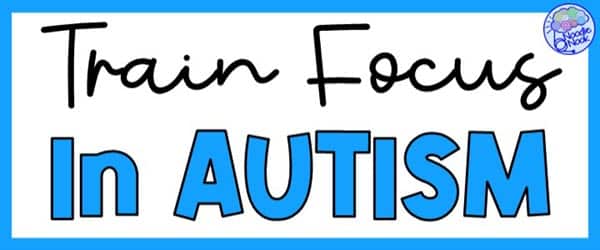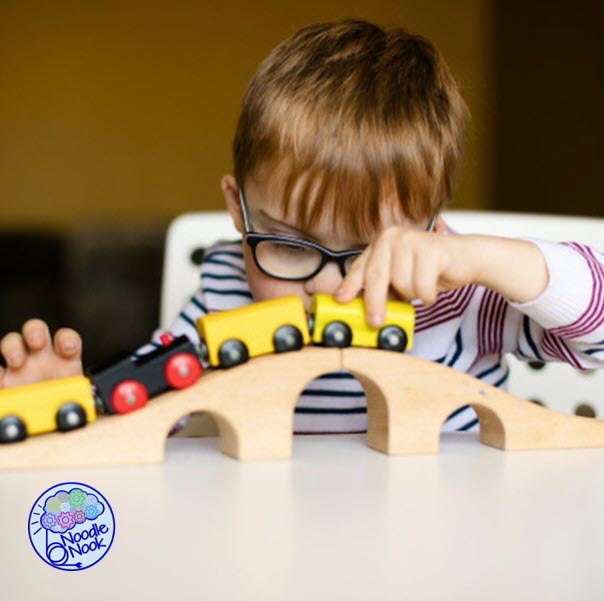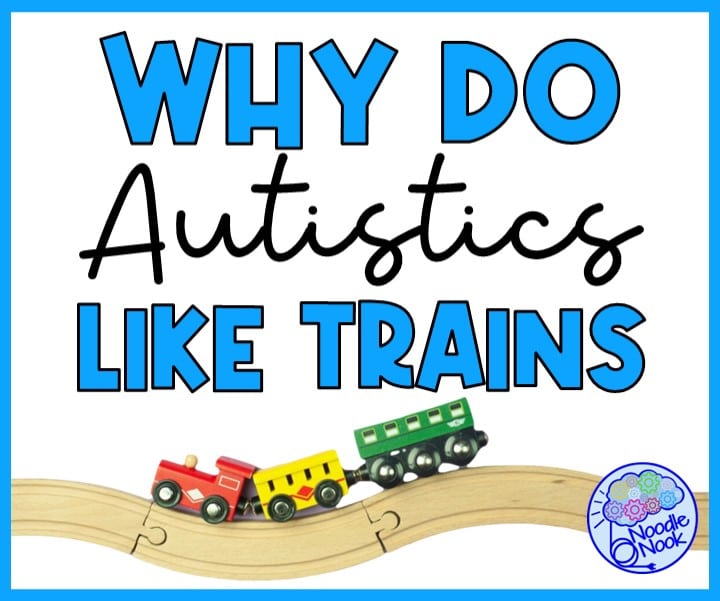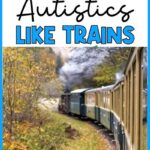Have you ever wondered why people with autism spectrum disorder have a strong affinity for trains? As a K-12 teacher, you may have noticed some of your autistic students expressing a keen interest in train-related activities, such as playing with toy trains or reciting train numbers. Trains, with their predictability, technical details, and sensory experiences, are a perfect fit for the intense interests that many autistic individuals have. In this blog post, we’ll explore exactly why do autistic people like trains so much and how you can use this knowledge to better support students with autism in your classroom. So, all aboard!
What Is Autism Spectrum Disorder?
Autism Spectrum Disorder (ASD) is a neurodevelopmental disorder that affects an individual’s ability to communicate, interact socially, and understand and respond appropriately to social cues. While every person with autism is unique, common traits include a preference for routine and predictability, intense interests in specific topics, and sensory sensitivities.
It’s important to note that being on the autism spectrum is not a disease, but rather a different way of processing information and experiencing the world. With proper support and understanding, autistic individuals can be successful and positively contribute to society.
Special Interests and Autism
Special interests are a common trait of individuals on the autism spectrum and refer to a deep and intense fascination with a particular topic or activity. These interests often develop at a young age and can become a significant part of an individual’s daily life. They can range from topics like trains, dinosaurs, or video games to specific activities like drawing, collecting, or playing an instrument. One of my most favorite students was hyper-interested in basketballs. He loved the different brands, could tell us so many details about each that I never knew, and his favorite reading was a sports equipment catalog. It was his happy place.
For students with autism, special interests can be a source of joy, comfort, and a way to cope with the sensory challenges and social interactions they may face in and out of the classroom.
Why Do Autistic Individuals Have Intense Interests?
Autistic individuals have intense interests because their brains process information differently than neurotypical individuals. The exact cause of this difference is still unknown. Researchers believe it has to do with the way the brain filters and prioritizes sensory information.
For autistic individuals, sensory input may be overwhelming. This leads them to focus intensely on a specific topic or activity as a way to cope. This intense hyperfocus can also be a way for autistic individuals to feel a sense of control and predictability in their environment. And that can be comforting in situations that are otherwise unpredictable or stressful. Additionally, having an intense interest can provide a sense of identity and purpose for individuals with autism. Most notably, this is by allowing them to connect with like-minded individuals and pursue their passions.
What are Some Benefits of Special Interests for Autistic Individuals?
Special interests can provide numerous benefits for autistic individuals. This includes improved social skills, increased self-esteem, and enhanced language skills. Engaging in a special interest can provide a sense of joy, comfort, and control. This can help reduce anxiety and stress. In turn, it can lead to better social interactions, as the individual may feel more relaxed and confident in social situations.
What are Some Examples of Common Special Interests (Other Than Trains)
There are a lot of things that can spark interest in a child, and a child with autism is no different. Reflecting on the common interest that have come up with my students who have autism over and over, I think one thing… These would all make great classroom themes! As you look over this list, consider how these could be themes for the year, even if you teach older children. They appeal to a lot of people and can really help hold a child’s attention, so why not?
- Dinosaurs: Many autistic individuals develop a deep fascination with dinosaurs. They may accumulate extensive knowledge about different species, their characteristics, and the prehistoric era.
- Space and astronomy: Exploring and learning about planets, stars, and galaxies can captivate the interest of autistic individuals. That can include studying space-related facts, watching documentaries, or engaging in stargazing activities.
- Computers and technology: With the ever-growing role of technology in our lives, this one is no surprise. Autistic individuals often develop a special interest in computers, programming, or other technological devices. They may enjoy coding, building computers, or exploring the latest gadgets.
- Musical instruments: Some autistic individuals show remarkable talent and passion for playing musical instruments. Whether it’s the piano, guitar, drums, or any other instrument, they may spend hours honing their skills.
- Art and drawing: Autistic individuals often exhibit remarkable creativity and may have a strong affinity for art and drawing. They might focus on a particular art style, technique, or subject matter.
- Animals and wildlife: Many people develop a deep love and interest in animals, including both domestic and exotic species. Individuals with autism may become experts on a specific animal and their behaviors, habitats, and evolution.
- History: We all know a history buff! Some autistic individuals find solace and excitement in knowing about the past. They may have a strong interest in a specific era, war, or historical figure, accumulating vast knowledge. When it’s time to play trivia games, make sure they’re on your team!
- Sports: Autistic individuals may have a special interest in sports, both as spectators and participants. They may memorize sports statistics, watch games, collect trading cards, or participate in organized sports activities.
Does this list sound like an unusual collection of special interests? It’s not. Here’s the thing to remember: People with autism are interested in the same things as a neurotypical person. The difference, which can be profound, is the extent and the intensity of that interest.
Why Do Autistic People Like Trains?
Autistic people often have a strong affinity for trains due to the predictability, sensory experiences, technical details, and comfort that repetitive behavior can bring. For individuals with autism, being train lovers can stem from a variety of factors. This can include the following reasons:
- The abundance of train videos, TV shows, and books about trains. There are just a lot of trains out in the world! Seeing trains in so many ways provides a wealth of information and visual support. This can help individuals with autism build their knowledge and understanding of trains. There are also plenty of model trains and options for a train set from subway system sets to train stations. As a Lego lover, I can tell you trains are a huge part of Lego cities!
- Sensory experiences related to trains. Train rides can provide a unique sensory experience. This includes the feel of the train’s wheels on the tracks, the sound of the train’s horn, and the vibration of the train’s movement. It may even be the visual of train wheels rotating. These sensations can be soothing and comforting for individuals with autism, who may be hypersensitive to other sounds and stimuli in their environment.
- Predictability and routine of trains. Train schedules and routes tend to be consistent, which can help individuals with autism feel a sense of control and familiarity in their daily life. Additionally, the predictability of trains can help individuals with autism develop skills in time management, planning, and organization.
- Fascination with technical details and different types/sizes of trains. The intricate details and features of trains can be fascinating. Many individuals with autism enjoy learning and memorizing these technical details. Furthermore, the variety of different types and sizes of trains can provide a source of excitement and exploration. A tank engine is so different from a steam engine, it’s easy to get lost in the nuances!
- The role of repetitive behavior in the love of trains. Repetitive behavior is a common trait in individuals with autism, and the repetitive nature of train-related activities can be incredibly comforting. For example, playing with a train set or watching a train go around a track can be a calming and enjoyable experience.
The love of trains for individuals with autism can stem from a combination of factors, including those listed above. By understanding why a person with autism may have a hyperfocus on trains, it is easier to accept it and encourage that interest. After all, this interest may help an individual develop better interpersonal skills, foster connections, and provide joy. And there’s nothing wrong with that.
The Benefits of Trains for Autistic Children
If you think that having a hyper interest in trains is a liability for a child with autism, then it’s time to rethink things. In fact, there are several notable benefits that trains can offer to children on the autism spectrum.
- Calming effects of train-related activities: Engaging in train-related activities can have a calming effect on autistic children. The repetitive motions, predictable movements, and familiar sounds of trains can help reduce anxiety and provide a sense of comfort and relaxation.
- Development of language and social skills through train play: Playing with trains can be a powerful tool for the development of language and social skills. As children engage in imaginative play with trains, they have opportunities to communicate, engage in pretend play scenarios, and practice social interactions with peers or caregivers. This can foster the development of language skills, turn-taking, sharing, and cooperation.
- Improving focus and attention: The intricate nature of train sets and the task of arranging and organizing train tracks can help improve focus and attention for autistic children. As they engage in assembling tracks, connecting train cars, and maneuvering the trains, they are practicing skills such as problem-solving, planning, and concentration.
Truth of the matter is that it’s often better to lean into a child’s train interests rather than fight against it. That starts with acknowledging that there are benefits. Consider how to incorporate a child’s special interest into home life and instruction. It may be the key to improving focus, language skills, and behavior management in a child with autism.
Supporting Autistic Students in the Classroom with Trains
Trains are more than just fascinating for individuals with autism; they can be a powerful tool for supporting learning and development in the classroom. For many students on the autism spectrum, trains provide a sense of comfort and familiarity in a world that can often feel overwhelming. By incorporating trains into classroom activities, educators can create an inclusive and engaging learning environment that meets the unique needs and interests of their autistic students. Here are some practical strategies and tips for supporting autistic students in the classroom with trains:
Incorporating Train-Related Activities Into The Classroom
Incorporating train-related activities into the classroom can profoundly impact the learning and development of autistic students. These benefits can support non-autistic children as well. After all, kids with and without autism love trains!
- Create a train-themed reading corner or designated train play area, complete with train-themed books, cushions, and toy trains. This cozy space can be a haven for autistic students to immerse themselves in the world of trains and enjoy reading train-related stories.
- Integrate train-related puzzles, games, or coloring activities during free time. Provide puzzle sets featuring train images, engaging board games with train themes, or coloring pages with train illustrations. You may also try incorporating rotating toys for students with visual preferences or stims. Overall, these activities offer both enjoyment and cognitive stimulation.
- Plan train-related art projects, such as drawing or painting train scenes. Encourage students to unleash their creativity by designing their own trains, landscapes, or even creating a collaborative train mural. This artistic expression allows autistic students to engage with trains in a visually expressive and personal way.
- Organize a train-building station where students can construct train models using building blocks or train-themed construction kits. This hands-on activity is a great way to promote fine motor skills, spatial awareness, and problem-solving abilities while fostering a sense of accomplishment and engagement.
- Plan a virtual train trip where students can see trains in action. You can plan on visiting train museums throughout the country. A virtual visit to New York City or New Jersey will let you stop at the subway station or train station and see the transit systems up close. You can also make a special visit to the New York Transit Museum or the National Railway Museum.
- Start an after-school program for train lovers, especially if you are in secondary school. Feeling adventurous? Take your virtual field trips to the next level and reserve time for this high-interest topic for after school. Then, there’s an opportunity to explore the public transportation systems abroad! Train enthusiasts can talk and see different types of trains in action, like a steam train, a commuter train, and high speed rail outside of the classroom with friends who have similar interests.
There are plenty of opportunities for adding train-related activities into the classroom.
Using Train Toys as Visual Supports to Enhance Learning
Toy trains can be excellent visual supports for autistic students in the classroom. They leverage a student’s interest in trains to promote engagement, comprehension, and cognitive development. Here are some train visuals to try:
- Incorporate train toys for hands-on demonstrations of concepts such as counting, sorting, or patterns. Students can use the train cars to practice counting objects, arrange them in specific sequences, or group them based on attributes like color or size. This interactive approach brings abstract concepts to life and facilitates a deeper understanding.
- Utilize visual supports featuring train images to aid comprehension and organization. Create visual schedules with train icons to help students understand and navigate daily routines. Use visual task cards or visual step-by-step instructions to guide students through activities involving train play, encouraging independence and reinforcing sequential thinking.
- Introduce train-themed storybooks or flashcards to support language and literacy skills. Engage students in reading train-related stories together, promoting language development and storytelling abilities. Flashcards with train-related vocabulary can also be used for word recognition and expanding language skills.
- Set up a train-themed sensory station where students can explore different textures and sensory materials related to trains. Incorporate train tracks, train wheels, or model train parts that students can touch and manipulate. This sensory-rich experience stimulates their senses while nurturing their curiosity and exploration.
Suddenly your brain is on overdrive thinking all the ways to incorporate chains into your classroom, right? The possibilities are endless. Most importantly though is that you have plenty of opportunities to engage a student with a hyper interest in trains in their daily instruction.
Incorporating Social Skills Practice into Train Play
It may not seem like it, but pairing social skills and trains may be the ticket to improving social-emotional learning (SEL) and character development in the classroom. Train play is a fantastic way to promote meaningful interactions in the classroom. Also, it may be a way to target problem-solving skills for students with autism. Here are some things to consider:
- Encourage cooperative play with train sets, fostering turn-taking and sharing. Create opportunities for students to engage in collaborative train play, where they take turns operating the trains, setting up tracks together, and sharing resources. This cooperative play promotes social skills such as sharing, patience, and teamwork.
- Facilitate role-playing scenarios using trains to practice social interactions and problem-solving. Encourage students to create narratives and act out different social situations using train characters. They can practice greetings, conversations, and resolving conflicts within the context of their train play. You can also work on recognizing facial expressions and nonverbal communication. Interactive role-playing nurtures empathy, communication skills, and conflict-resolution strategies, which all students need!
- Collaborate with an occupational therapist to uncover the best way to meet the individual social needs of students. Occupational therapists can provide valuable insights and guidance on tailoring train play activities to address specific social challenges or developmental goals. By working together, educators and therapists can create a supportive and targeted approach to social skills development.
RECAP: Why Do Autistic People Like Trains
The connection between autism and trains is a fascinating one. Whenever a child in the classroom has a specific interest, it falls upon us as teachers to find a way to help them be successful. By understanding the reasoning and benefits of a hyper interest, such as trains, we can cater to the unique needs of a student with autism. So it’s time for you to dust off your childhood model trains and tap into all the ways you can incorporate train-related activities into the classroom. Remember, it’s not about the trains, it’s about all the benefits trains can offer. That includes things like calming effects, language, and social skill development as well as improved focus and attention. Most importantly, though, is that it can help you create a more positive and engaging learning environment that’s inclusive to all… and that’s something to toot your own horn about.
Was that last pun too much? I may have lost my train of thought…









